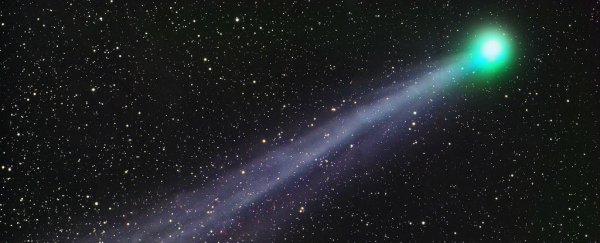For the first time ever, scientists have caught a comet releasing ethyl alcohol - the exact same type of alcohol in your liquor cabinet. The presence of alcohol on Comet Lovejoy (C/2014 Q2), along with a simple sugar called glycolaldehyde and 19 other organic molecules, adds further evidence to the idea that comets were the origin of ingredients needed for life to arise on Earth.
"We found that comet Lovejoy was releasing as much alcohol as in at least 500 bottles of wine every second during its peak activity," said lead researcher, Nicolas Biver, from the Paris Observatory in France.
First discovered in August 2014, Comet Lovejoy (C/2014 Q2) made its closest flyby of the Sun on 30 January this year. The intense heat of this encounter caused it to release several clouds of gas into the surrounding area, while sweating out water molecules at a rate of 18 tonnes per second. Biver and his team were able to figure out the composition of this gas using observations from the Pico Veleta radio telescope in Spain.
The Sun's role in the discovery wasn't just to warm the surface of the comet enough to make it release clues about its chemical composition. The way sunlight interacts with molecules in the comet's atmosphere causes them to glow at specific microwave frequencies, and it's these 'microwave glows' that give away the specific signatures of the molecules, allowing scientists to identify them.
Thought to be frozen remnants from the formation of the Solar System 4.6 billion years ago, comets are an invaluable source of information about what base materials were present during the birth of our planet. It's thought that when gas clouds produced by exploding stars - or supernovae - mix with winds from dying red giants, they can compress themselves into a highly concentrated cloud of stellar material that collapses under its own gravity to form new stars and planets.
These star- and planet-forming gases collect grains of dust, on which carbon dioxide, water vapour, and other gases accumulate and freeze, before radiation converts them into different types of organic molecules. These grains of dust are then gathered up inside comets and asteroids.
Scientists have hypothesised that several comets laden with organic molecules impacted Earth soon after its birth, distributing them on its surface. The latest observations of Comet Lovejoy now lend weight to this idea. "The result definitely promotes the idea the comets carry very complex chemistry," said one of the team, Stefanie Milam from NASA's Goddard Space Flight Centre in the US.
Milam explains that during the Late Heavy Bombardment about 3.8 billion years ago, it's thought that many comets and asteroids were slamming into Earth, possibly delivering the water that would form our first oceans. But the origins of life didn't necessarily have to start with just simple molecules like water, carbon monoxide, and nitrogen, she says:
"Instead, life had something that was much more sophisticated on a molecular level. We're finding molecules with multiple carbon atoms. So now you can see where sugars start forming, as well as more complex organics such as amino acids - the building blocks of proteins - or nucleobases, the building blocks of DNA. These can start forming much easier than beginning with molecules with only two or three atoms."
The next step will be for researchers to figure out if the alcohol, sugar, and other organic molecules found on Comet Lovejoy originated from the primordial cloud that formed the Solar System, or if they were gathered from another source much later on. Philae, the European Space Agency spacecraft that spent 60 hours on Comet 67P/C-G last year, found evidence of 16 organic molecules on the surface, which means they can now figure out how uniform these compositions really are.
The results have been published inScience Advances.
